An unspecified diagnosis is used when a clinician has determined that a child’s challenges fall within a certain group of disorders, but it’s not clear exactly which diagnosis in that group best suits the child.
What Is an Unspecified Diagnosis?
When kids are struggling, but specific diagnoses don’t quite fit
en EspañolSometimes children receive a mental health or learning disorder diagnosis that is labeled as “unspecified.” For example, instead of being diagnosed with a particular anxiety disorder like separation anxiety disorder or social anxiety disorder, their diagnosis might say “unspecified anxiety disorder.”
An unspecified diagnosis is used when a clinician has determined that a child’s challenges fall within a certain group of disorders, but it’s not clear exactly which diagnosis in that group best suits the child.
Unspecified diagnoses are not just for children. Adolescents and adults can receive unspecified diagnoses as well.
Sometimes clinicians use unspecified diagnoses when a child needs care but there’s not time for a full evaluation. This might apply in urgent situations like emergency room visits.
In non-emergency situations, these diagnoses are used when the clinician needs to see how the child’s symptoms develop before making a more specific diagnosis. Especially if the child’s symptoms started recently or if they are relatively mild, it can take time to understand exactly what the child is experiencing and how their symptoms affect their life. Waiting to make a more specific diagnosis also lets the clinician gather more information about the various factors that might affect the child’s symptoms — such as substance use, medical conditions, or environmental factors like stress at home.
Often, a clinician will make an unspecified diagnosis with the goal of making a more specific diagnosis later. However, unspecified diagnoses can also be helpful for kids who are clearly struggling but who don’t exactly meet the criteria for a more specific disorder, even after some time has passed.
Kids with unspecified disorder diagnoses can often get the same kinds of treatment as kids who have been diagnosed with specific disorders, and insurance is just as likely to cover that treatment.
Unspecified disorders that children and teenagers can be diagnosed with include:
- Unspecified anxiety disorder
- Unspecified depressive disorder
- Unspecified behavior disorder
- Unspecified attention-deficit hyperactivity disorder (ADHD)
- Unspecified bipolar disorder
- Unspecified obsessive-compulsive or related disorder (OCD)
- Unspecified feeding or eating disorder
- Unspecified tic disorder
There is also a similar set of diagnoses known as “other specified” diagnoses, which you can learn more about here. The difference is that an “other specified” diagnosis has to be very close to meeting the criteria for a specific disorder, and the clinician has to explain why it doesn’t quite meet the criteria.
You might also see diagnoses that use the term “NOS,” which stands for “not otherwise specified.” This terminology comes from a previous version of the DSM, the manual that clinicians use to make diagnoses. NOS diagnoses were officially discontinued with the publication of the DSM-5 in 2013, but some clinicians may still use them. NOS diagnoses work the same way as unspecified diagnoses in practice.
Frequently Asked Questions
In a non-emergency situation, an unspecified mental health diagnosis is used when the clinician needs to see how the child’s symptoms develop before making a more specific diagnosis. Sometimes it can take time to understand exactly what the child is experiencing and how their symptoms affect their life.
The difference is that an “other specified” diagnosis must be very close to meeting the criteria for a specific disorder — and the clinician has to explain why it doesn’t quite meet the criteria. Unspecified means the clinician is not yet sure which diagnosis best fits.
Was this article helpful?
Related Reading
-
 What Should You Look for in a Diagnosis?
Signs a clinician is evaluating your child with care
What Should You Look for in a Diagnosis?
Signs a clinician is evaluating your child with care
-
 What Is an “Other Specified” Diagnosis?
When symptoms don’t exactly match a specific disorder
What Is an “Other Specified” Diagnosis?
When symptoms don’t exactly match a specific disorder
-
 What Are V Codes and Z Codes in a Diagnosis?
Treating challenges that aren’t disorders
What Are V Codes and Z Codes in a Diagnosis?
Treating challenges that aren’t disorders
-
 How to Tell Your Child About Their Autism Diagnosis
Tips for talking to kids about autism, and why it’s important to tell them
How to Tell Your Child About Their Autism Diagnosis
Tips for talking to kids about autism, and why it’s important to tell them
-
 Complete Guide to Getting Good Care
When a child is struggling, or their behavior worries you, it can be hard to…
Complete Guide to Getting Good Care
When a child is struggling, or their behavior worries you, it can be hard to…
-
 Complete Guide to Developmental Milestones
A guide to normal childhood development that can help you recognize when your child might…
Complete Guide to Developmental Milestones
A guide to normal childhood development that can help you recognize when your child might…
-
 What Is Inattentive ADHD?
Kids don’t have to be hyperactive to have ADHD
What Is Inattentive ADHD?
Kids don’t have to be hyperactive to have ADHD
-
 Why Autism Diagnoses Are Often Delayed
How ADHD and sensory processing issues can prevent early intervention
Why Autism Diagnoses Are Often Delayed
How ADHD and sensory processing issues can prevent early intervention
-
 Why Do Black Children With Autism Get Diagnosed Late?
Exploring the many barriers faced by Black parents who seek early intervention for their child
Why Do Black Children With Autism Get Diagnosed Late?
Exploring the many barriers faced by Black parents who seek early intervention for their child
-
 Sharing an Autism Diagnosis With Family and Friends
Tips for explaining autism to family and close friends, to help them become effective allies
Sharing an Autism Diagnosis With Family and Friends
Tips for explaining autism to family and close friends, to help them become effective allies
-
 Misdiagnosis of Mood Disorders in Black Teenagers
What we know about it, and how parents can help kids get the right diagnosis
Misdiagnosis of Mood Disorders in Black Teenagers
What we know about it, and how parents can help kids get the right diagnosis
